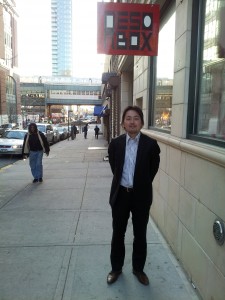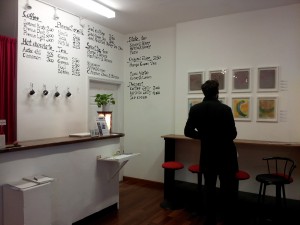JQ Magazine: JQ&A with Takashi Ikezawa of Resobox Japanese Art Gallery

“We don’t want art to be only for wealthy people, but instead want to target as wide an audience as possible for the purpose of disseminating Japanese culture. This is actually the reason why we chose to be located in Queens, as it is said to be the most diverse part of the city.” (Stacy Smith)
By Stacy Smith (Kumamoto-ken CIR, 2000-03) for JQ magazine. Stacy is a professional Japanese writer/interpreter/translator. She starts her day by watching Fujisankei’s newscast in Japanese, and shares some of the interesting tidbits and trends together with her own observations in the periodic series WITLife.
In recent years, Long Island City has experienced a rapid gentrification, being converted from an abandoned, industrial wasteland to a hotspot of waterfront apartments and art institutions. Of course it has big hitters like the Noguchi Museum that are well known to Japanophiles, but there are also Japan-related galleries flying under the radar just waiting to be discovered. One such place is Resobox, a short walk from the Queensboro Plaza subway stop whose location is marked by only a small, overhanging sign and a signboard that sits on the sidewalk reading: “The place where people who are conversant with, dedicated to and influenced by Japanese art can gather, create innovative arts through the collaborative process and disseminate them to the world.” Interest piqued? So was mine, and I was fortunate to have the opportunity to speak with Resobox co-owner Takashi Ikezawa to learn more about this unique endeavor.
Can you share with JQ readers Resobox’s back story and the origin of your name?
Resobox was a name created from the words “resonate” and “box,” and it refers to a space where artists can meet and collaborate to create new and innovative art. It initially referred to a project begun by my partner Fumio Tashiro, a jazz musician who became interested in experimental music and music as art performance. He would collaborate with dancers, painters, and musicians to put together performances. I had a business background as I worked at a talent agency representing Japanese artists in NYC, and I knew Fumio casually. However, we started meeting up monthly to brainstorm, and our discussions always focused on the breadth and depth of Japanese culture and arts. In order for a solid collaboration to take place, you need to have a strong foundation. Since we are both Japanese, we found the culture of our native country to be a foundation substantial enough to build on. Our brainstorming sessions yielded the idea of artists, both Japanese and non-Japanese, coming to our box and resonating off each other to create new Japanese art. This is how Resobox was launched in its gallery form in June of 2011.
Can you give an example of some successful collaborations?
One of the artists who was featured until early January, Mary Burton Wheeler, became involved by taking a Japanese ink painting (sumi-e) class at Resobox. It happened to be taught by Ayakoh Furukawa, the artist we currently have on display, and collaboration began in this class environment. Wheeler learned not just about Japanese painting itself but about Japanese sense and ideas, and she incorporated this into the new pottery she produced as a result. On first glance you wouldn’t say that her work is particularly “Japanese,” but on closer look there is definitely a Japanese sensibility that she encountered via her collaboration with Ayakoh.
I see you have a great café with some Japanese offerings.
Yes, we just want to get people in the gallery, and we welcome everyone regardless of whether they have an interest in Japan and art or not. They might just be coming in for coffee or to get out of the cold, but we hope that they stay for a while. We know that everyone in NYC is busy, but if we can have a few minutes of their time where they walk around the gallery, we are happy. We serve Japanese treats like coffee and matcha flavored jelly, yuzu, matcha and sesame shakes, as well as standard Japanese teas.
What types of classes do you offer and are they open to everyone?
Our classes are open to the public and we want to have many local participants. Our goal is to have collaborations between students or between instructor and students that leads to the cultivation of new artists among the attendees. Class topics range from drawing of anime and manga to traditional martial arts to dance, and priced at $15-$20 they are very accessible. We don’t want art to be only for wealthy people, but instead want to target as wide an audience as possible for the purpose of disseminating Japanese culture. This is actually the reason why we chose to be located in Queens, as it is said to be the most diverse part of the city.
How do you find the artists you feature?
If someone is interested in exhibiting at Resobox, we will first screen their portfolio and if we see potential we will then visit their studio to exchange ideas. We are open to artists of any age, race or nationality; the only condition is that they somehow incorporate Japanese culture into their work through the creation of something new that didn’t exist before. For this purpose, we will introduce them to someone of Japanese background who they can interact with and learn from and vice versa. Via this influence, the artists will then be able to give birth to new Japanese-influenced creations. Ideally, we would like to do group exhibitions where participating artists make works together. They would have a synergy that allows them to create things they wouldn’t be able to on their own.
What can JQ readers look forward to from Resobox in the near future?
We usually hold about four to five Japanese cultural events per month, and they run the gamut from live music to Okinawan dance. We plan to continue at this pace, and also add additional aspects such as tea culture exchange. In February we are scheduled to have a tea demonstration given by Chinese and Japanese tea masters, who will compare and contrast their countries’ respective tea ceremony styles. We also hope to continue our involvement with the neighborhood, because the more we are accepted by the locals, the better chance we have of promoting Japanese culture.
Resobox is located at 41-26 27th Street in Long Island City. Upcoming exhibitions include Vintage Kimono and Doll – An Elegant Rustling of Silk (opens Feb. 4) and RGB – Solo Exhibition by Satoshi Tsuchiyama (opening reception Feb. 22 at 7:00 p.m.). For more information, visit http://resobox.com.



Comments are closed.